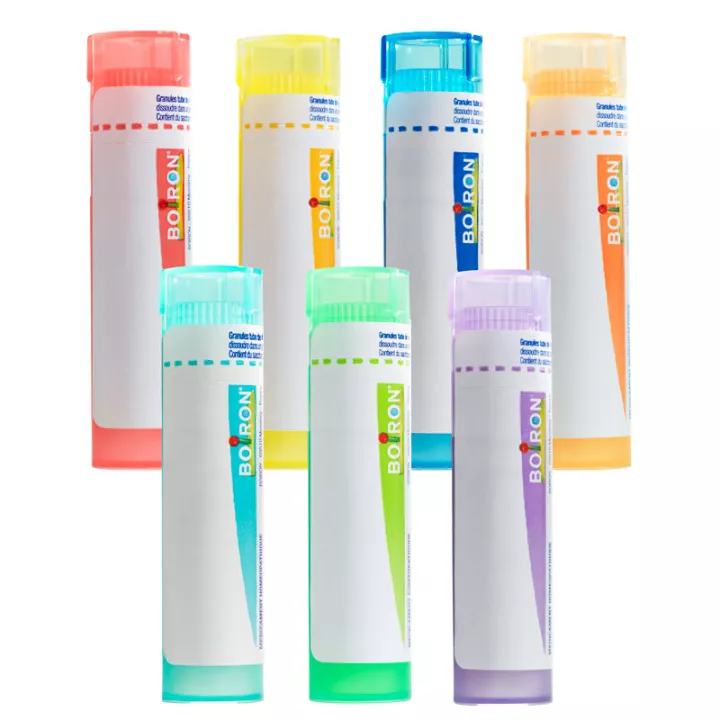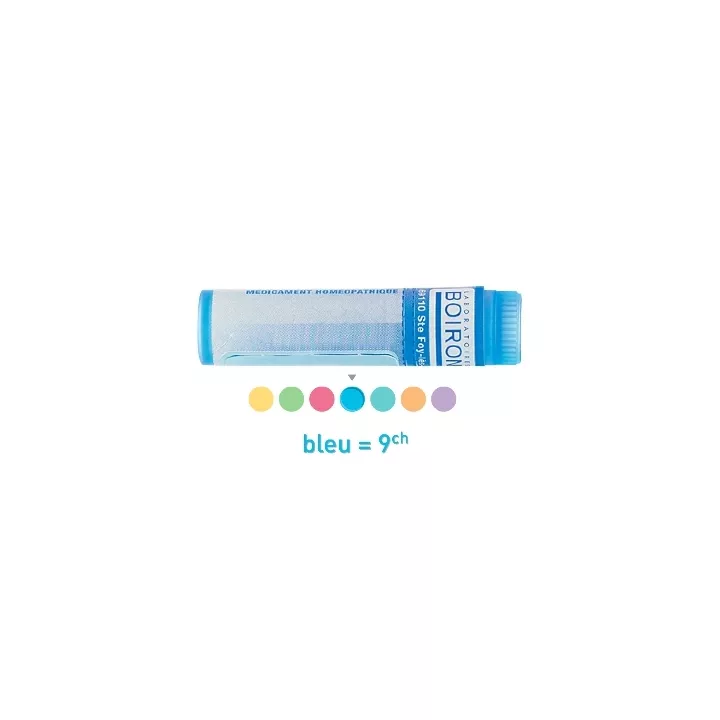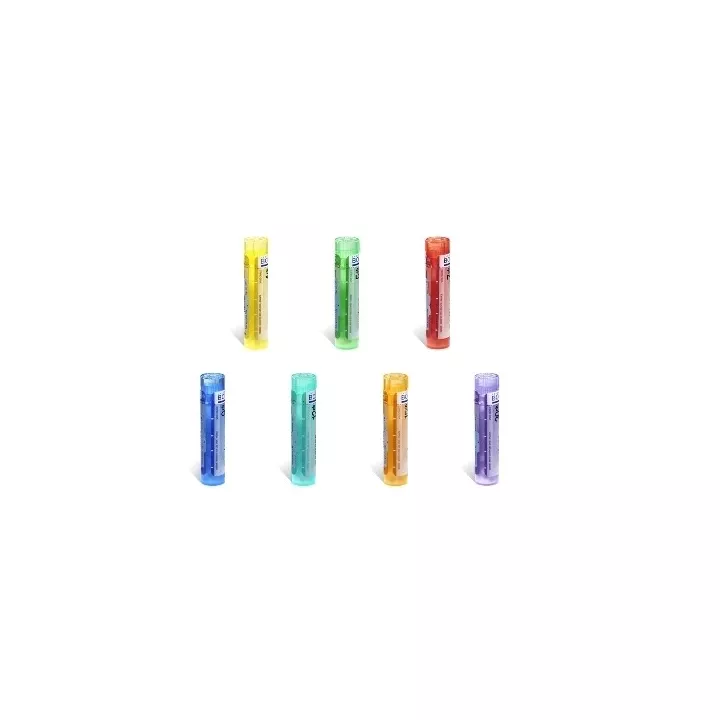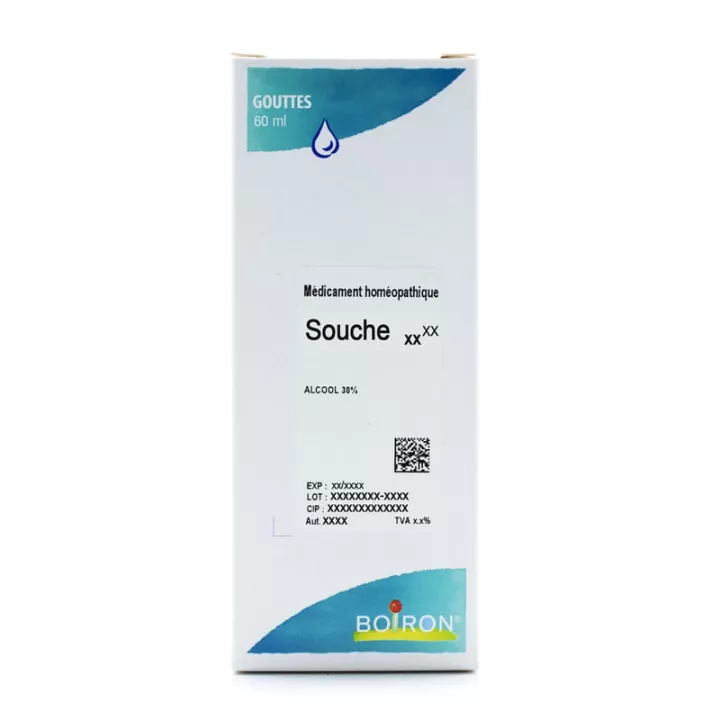Berberis vulgaris, commonly known as barberry, is a leading plant strain in the field of homeopathy. Its inclusion in the French and European pharmacopoeia testifies to its importance and widespread use in homeopathic practice for the treatment of various health conditions.
Berberis Vulgaris Overview
Available forms: Granules - Doses
Scientific name: Berberis Vulgaris
Main indications: Digestive disorders, back pain
Homeopathic strain in Korsakovian dilution 200 K, 1,000 K (or MK or 1MK)
Homeopathic origin and properties
Berberis Vulgaris comes from a thorny shrub called barberry, belonging to the Berberidaceae family. The plant parts mainly used in homeopathy are the dried roots and, more specifically, the bark. The Berberis mother tincture of this plant is made from these elements.
Indications and dosage
Homeopathic medicines in granule tubes or globular doses can be used for a variety of symptoms, so it's not possible to determine the indications and dosage of a specific preparation.
The homeopathic physician selects the appropriate medicine, dilution and dosage according to the patient's state of health and characteristic symptoms.
Berberis vulgaris, with its wide range of dilutions and recognized presence in the pharmacopoeia, is a valuable therapeutic option in homeopathic practice. Its plant origin and registration as a homeopathic medicine ensure its quality and reliability. Practitioners thus have a wide range of solutions to meet their patients' needs in a personalized way, based on the fundamental principles of homeopathy to promote health and well-being.
Therapeutic applications
Berberis Vulgaris is indicated for a variety of medical conditions:
Urinary lithiasis
- Symptoms: Back pain, burning, bruising in the kidneys, especially on the left side.
- Nature of urine: Variable quantity and appearance.
Specially indicated to treat urinary lithiasis, Berberis vulgaris is effective in both men and women. Typical symptoms of this pathology, such as back pain, burning or even variations in urine color, find notable relief with this remedy. It is also commonly used to treat associated male sexual complications, such as reduced libido and premature ejaculation.
Hepatovesicular disorders
- Symptoms: Labored digestion, nausea, thick saliva, postprandial somnolence, alternating constipation and diarrhea.
Used for its beneficial properties on the liver system, Berberis vulgaris is also recommended in cases of difficult digestion, persistent nausea and fluctuation between diarrhea and constipation. In women, urological disorders can extend to the vulva, causing pain during orgasm, also alleviated by this treatment.
Circinate dermatoses
- Examples: Pityriasis rosé de Gibert, ring or arc forms.
In dermatology, Berberis vulgaris is particularly effective in the treatment of circinate dermatoses and Gibert's pink pityriasis. Often manifested by itching, these skin conditions find relief with this versatile remedy.
Gout crisis
- Symptoms: Inflammation of joints, particularly the big toe.
Particularly effective in the management of rheumatic disorders, Berberis vulgaris regulates uric acid metabolism. This remedy is therefore prescribed in cases of joint pain associated with urinary inflammatory complications, often linked to overproduction of urea.
Lumbar and lumbosacral pain
- Affected area: Lumbar vertebrae and sacrum.
Directions for use
Remove tab, invert tube and pull cap slightly.
Turn the tube to drop the desired number of granules into the cap, then place the granules under the tongue.
Do not touch the granules or globules with your fingers.
The globules in the dose tubes are absorbed in one go, dissolving slowly under the tongue. If no dose is available, take 10 granules of the same dilution.
Do not take astringent substances such as coffee, tobacco, camphor, mint or chamomile within half an hour of taking homeopathic medicines.
Use mint-free toothpaste (such as Homéodent Boiron, toothpaste compatible with taking homeopathic granules).
Standard dosage:
Berberis Vulgaris 4 to 5 CH: Take 5 granules in the morning and at bedtime.
An individual approach to each condition
The efficacy of Berberis vulgaris in homeopathy is indisputable, but optimal use requires an appropriate dosage. Here are some guidelines for personalized dosing in different areas of application.
Dosage in Urology and Rheumatology
When Berberis vulgaris is used to treat urological or rheumatological disorders, the 5 CH formulation is often recommended. The general dosage is 5 granules, to be administered twice a day, morning and evening. It is important to continue treatment until a significant improvement in the patient's condition is achieved.
Dosage in Hepato-Gastro-Enterology
For hepato-gastroenterological disorders, the preferred formulation is Berberis vulgaris 6 DH. The recommended dosage is 20 drops diluted in a glass of water, to be taken morning and evening before meals. To maximize absorption, hold the solution in the mouth for a few seconds before swallowing. Treatment may last up to 3 months, depending on the severity of the condition. A gradual reduction in dosage is possible once improvements are noted. To treat specific hepatovesicular disorders, a combination with other homeopathic remedies may be required.
Dosage in Dermatology
For dermatological conditions, Berberis vulgaris can be used either as granules or drops. The standard dose for the granule formulation is 10 granules per day, divided into two doses. If you opt for the drop formulation, the recommended concentration is 6 DH, and 20 drops should be diluted in a little water.
Who is BERBERIS VULGARIS 200K or MK recommended for?
This remedy is recommended for those seeking a natural solution for kidney and biliary disorders, lower back pain, and much more.
How to use BERBERIS VULGARIS 200K or 1000K?
Follow the recommendations of a healthcare professional for the dilution and frequency appropriate to your situation.
Q: Is BERBERIS VULGARIS 200K suitable for all ages?
Yes, but it is advisable to consult a healthcare professional for children and pregnant women.
Pharmacist's recommendations
For hepato-vesicular disorders, Berberis Vulgaris is often prescribed in association with other homeopathic medicines such as Taraxacum dens leonis, Carduus marianus, Chelidonium majus and Solidago virga aurea.
Important note
It's crucial to consult a healthcare professional to establish a precise diagnosis and personalize treatment, especially in cases requiring a combination of several remedies.
Berberis vulgaris is available in a variety of formulations and dosages to provide individualized treatment for specific conditions. Compliance with dosage guidelines is essential to maximize the therapeutic benefits of this versatile remedy.
Packaging and contents
- Translucent granule tube (for easy viewing of remaining granules). Weight 4g. Approx. 80 granules.
- Single-dose tube of translucent globules (for visualization of remaining globules). Weight 1g.
isponibility and Formulations
This strain is available in various forms, including doses, tubes and magistral preparations. The range of Hahnemannian and Korsakovian dilutions enriches the palette of choices available to practitioners, enabling precise adaptation of treatment to the specific needs of each patient.
Origin and authentication
Of plant origin, Berberis vulgaris is rigorously selected for its beneficial properties. Its registration under number EH00047 validates its status as a recognized homeopathic medicine, guaranteeing patients and healthcare professionals access to a trusted, high-quality remedy.
Variety of dilutions : A made-to-measure approach
The Berberis vulgaris-based remedies available from BOIRON, for example, cover a wide spectrum of dilutions, from 2 CH to 30 CH in Hahnemannian dilutions, and up to 10,000K in Korsakovian dilutions. This diversity makes it possible to adjust treatment to the individuality of each patient, following a logic of personalization specific to homeopathy.
Korsakovian dilutions: an additional dimension to treatment
In addition to traditional Hahnemannian dilutions, Berberis vulgaris is also available in Korsakovian dilutions, a method that offers high potencies such as 200K, 1,000K and 10,000K. These specific dilutions make it possible to fine-tune the treatment, offering practitioners additional flexibility in managing complex pathologies.
Precautions for use
Warning
Contains sacchararose.
Store homeopathic medicines away from light, heat, moisture, fumes and fragrances.
Giving homeopathic granules to babies and children
For granules or alcoholic drops, dissolve in 100ml of water. Granules take a long time to dissolve, so it's best to prepare your mixture in advance.
Homeopathy and pregnancy
Homeopathic medicines have no chemical toxicity, no contraindications, no interaction with other drugs, and no adverse effects linked to the quantity of product ingested. Pregnant women can take homeopathic medicines with no known risk to themselves or their unborn child, but it is advisable to seek advice.
Frequency of homeopathic use
For acute conditions, homeopathic remedies should be taken every hour until symptoms improve. From then on, they should be taken 3 or 4 times a day, spaced out, and then gradually stopped.
For chronic conditions, low-dilution remedies (> 9CH) should be taken 1 or 2 times a day, while basic remedies should be taken once a week, or even once a month. This decision is left to the homeopath.
What to do if there is no improvement within 24 hours
Certain pathologies cannot be treated with homeopathy simply by self-medication. Their seriousness requires medical advice, which can be given by a homeopathic doctor. This doctor will judge whether your condition can be treated with homeopathy alone, or whether your treatment needs to be supplemented with allopathic medicine.

















